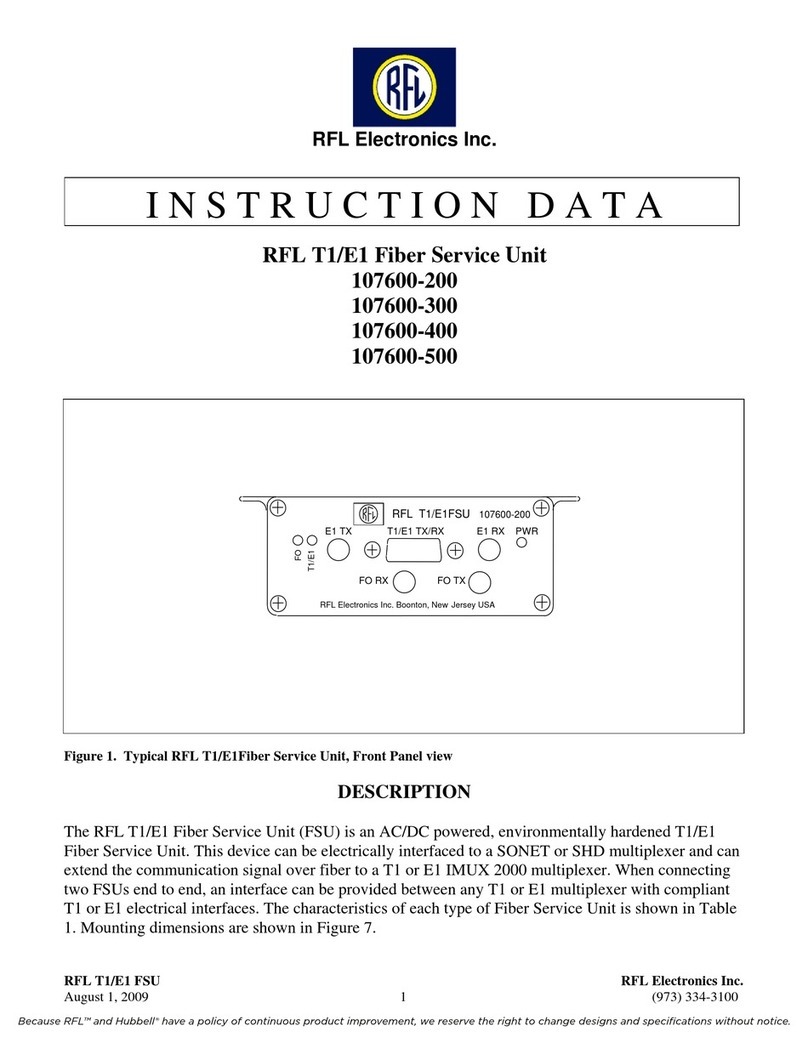
Because RFL™ and Hubbell® have a policy of continuous product improvement,
we reserve the right to change designs and specifications without notice.
IMUX 2000 DACS8P RFL Electronics Inc.
April 18, 2007 viii (973) 334-3100
4.1.13 SAG I/O FOR DACS-R, MA 255...................................................................................................................4-27
4.1.14 POWER SUPPLY ALARM I/O MODULE...................................................................................................4-28
4.1.14.1 DESCRIPTION........................................................................................................................................4-28
4.2 DETERMINING DACS CHASSIS POWER REQUIREMENTS ..........................................................................4-30
Section 5. REDUNDANT DACS THEORY OF OPERATION..........................................................................................5-1
5.1 INTRODUCTION......................................................................................................................................................5-1
5.1.1 SYSTEM LEVEL ...............................................................................................................................................5-1
5.2 HARDWARE..............................................................................................................................................................5-2
5.2.1 COMMON FEATURES ......................................................................................................................................5-2
5.2.1.1 JTAG.............................................................................................................................................................5-2
5.2.1.2 PROGRAMMABLE TESTPOINTS.............................................................................................................5-3
5.2.1.3 ACTEL ID & REVISION.............................................................................................................................5-3
5.2.1.4 ECB REVISION ...........................................................................................................................................5-3
5.2.2 SYSTEM LEVEL ................................................................................................................................................5-3
5.2.3 PROCESSOR MODULE.....................................................................................................................................5-4
5.2.3.1 OVERVIEW .................................................................................................................................................5-4
5.2.3.2 POWER SUPPLY.........................................................................................................................................5-4
5.2.3.3 PROCESSOR................................................................................................................................................5-6
5.2.4 FRAMER MODULE ...........................................................................................................................................5-8
5.2.5 REDUNDANCY MODULE..............................................................................................................................5-11
5.3 DACS FUNCTIONAL DESCRIPTION...................................................................................................................5-13
5.3.1 PORT SETTINGS..............................................................................................................................................5-13
5.3.1.1 PORT MODES............................................................................................................................................5-13
5.3.1.2 PORT CONFIGURATION.........................................................................................................................5-14
5.3.2 PORT FAILURE DETECTION ........................................................................................................................5-14
5.3.3 DACS MAPPING FUNCTIONS.......................................................................................................................5-15
5.3.3.1 MAP DATA................................................................................................................................................5-15
5.3.3.2 RECEIVE DATA........................................................................................................................................5-17
5.3.3.3 TRANSMIT DATA ....................................................................................................................................5-17
5.3.4 ILS FUNCTIONS ..............................................................................................................................................5-18
5.3.5 HOT-STANDBY MODE...................................................................................................................................5-19
5.4 REDUNDANCY FUNCTIONAL DESCRIPTION .................................................................................................5-19
5.4.1 OVERVIEW ......................................................................................................................................................5-19
5.4.2 GENERAL CONVENTIONS............................................................................................................................5-20
5.4.2.1 SIGNAL PASSING.....................................................................................................................................5-20
5.4.2.2 SPEED.........................................................................................................................................................5-20
5.4.2.3 UNNECESSARY SWAPPING ..................................................................................................................5-20
5.4.3 FAULT DETECTION........................................................................................................................................5-20
5.4.3.1 FRAMER MODULE FAULT DETECTION.............................................................................................5-21
5.4.3.2 PROCESSOR MODULE FAULT DETECTION.......................................................................................5-22
5.4.3.3 REDUNDANCY MODULE FAULT DETECTION..................................................................................5-22
5.4.4 DECISION LOGIC............................................................................................................................................5-24
5.4.5 SWITCHING CONTROL..................................................................................................................................5-25
Section 6. INSTALLATION AND CHECK-OUT..............................................................................................................6-1
6.1 INTRODUCTION......................................................................................................................................................6-1
6.2 HARDWARE INSTALLATION...............................................................................................................................6-1
6.2.1 UNPACKING .....................................................................................................................................................6-2
6.2.1.1 INDIVIDUAL CHASSIS..............................................................................................................................6-2
6.2.1.2 INTERCONNECTED CHASSIS..................................................................................................................6-2
6.2.2 MOUNTING.......................................................................................................................................................6-3
6.2.2.1 INDIVIDUAL CHASSIS.............................................................................................................................6-4
6.2.2.2 INTERCONNECTED CHASSIS INSTALLED IN RACK OR CABINET................................................6-5
6.2.2.3 INTERCONNECTED CHASSIS MOUNTED ON SHIPPING RAILS .....................................................6-5
6.2.2.4 VENTILATION...........................................................................................................................................6-5
6.2.3 CONNECTIONS.................................................................................................................................................6-6




























